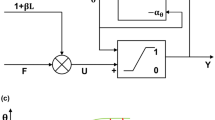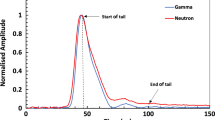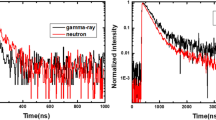Abstract
In fast neutron multiplicity counting measurement, misclassification of γ signals and loss of neutrons introduce significant measurement errors. To address these problems, machine learning (ML) algorithms were employed to improve the n/γ discrimination of liquid scintillators. A dual-scintillator time-of-flight device combined with charge comparison (CC) method was used to select reliable datasets from the D-T neutron generator. Decision Tree, Random Forest, and Back-Propagation Neural Network (BPNN) were developed and compared with the CC method. The CC method and ML algorithms were validated using 137Cs sources. The results showed that the ML algorithms had effective n/γ discrimination capabilities. The BPNN exhibited the highest DERγ (1.26%) and DERn (1.64%) discrimination performance, which reduced neutron loss and γ misclassification. In addition, the trained BPNN was used in practical measurement.














Similar content being viewed by others
Data availability
Data will be made available on request.
References
Li S, Qiu S, Zhang Q, Huo Y, Lin H (2016) Fast-neutron multiplicity analysis based on liquid scintillation. Appl Radiat Isot 110:53–58. https://doi.org/10.1016/j.apradiso.2015.12.064
Dolan JL, Flaska M, Poitrasson-Riviere A et al (2014) Plutonium measurements with a fast-neutron multiplicity counter for nuclear safeguards applications. Nucl Inst Methods Phys A 763:565–574. https://doi.org/10.1016/j.nima.2014.06.028
Chichester DL, Thompson SJ, Kinlaw MT et al (2015) Statistical estimation of the performance of a fast-neutron multiplicity system for nuclear material accountancy. Nucl Inst Methods Phys A 784:448–454. https://doi.org/10.1016/j.nima.2014.09.027
Di Fulvio A, Shin TH, Jordan T et al (2017) Passive assay of plutonium metal plates using a fast-neutron multiplicity counter. Nucl Inst Methods Phys A 855:92–101. https://doi.org/10.1016/j.nima.2017.02.082
Di Fulvio A, Shin TH, Basley A et al (2018) Fast-neutron multiplicity counter for active measurements of uranium oxide certified material. Nucl Inst Methods Phys A 907:248–257. https://doi.org/10.1016/j.nima.2018.05.049
Hou S, Luo J (2021) Improvement of plutonium sample property measurement based on fast neutron multiplicity counting. Ann Nucl Energy 156:108219. https://doi.org/10.1016/j.anucene.2021.108219
Zhou H, Lin H, Liu G, Li J, Liang Q, Zhao Y (2015) A neutron multiplicity analysis method for uranium samples with liquid scintillators. Nucl Inst Methods Phys A 797:70–76. https://doi.org/10.1016/j.nima.2015.06.029
Shin TH, Di Fulvio A, Clarke SD, Chichester DL, Pozzi SA (2019) Prompt fission neutron anisotropy in low-multiplying subcritical plutonium metal assemblies. Nucl Inst Methods Phys A 915:110–115. https://doi.org/10.1016/j.nima.2018.09.085
Shin TH, Feng PL, Carlson JS, Clarke SD, Pozzi SA (2019) Measured neutron light-output response for trans-stilbene and small-molecule organic glass scintillators. Nucl Inst Methods Phys A 939:36–45. https://doi.org/10.1016/j.nima.2019.05.036
Fobar D, Phillips L, Wilhelm A et al (2021) Considerations for training an artificial neural network for particle type identification. IEEE Trans Nucl Sci 68(9):2350–2357. https://doi.org/10.1109/TNS.2021.3103658
Zhang ZH, Hu CY, Fan XY et al (2019) A direct method of nuclear pulse shape discrimination based on principal component analysis and support vector machine. J Instrum 14:P06020. https://doi.org/10.1088/1748-0221/18/01/P01021
Kaplan AD, Blair B, Chen C et al (2019) A neutron-gamma pulse shape discrimination method based on pure and mixed sources. Nucl Inst Methods Phys A 919:36–41. https://doi.org/10.1016/j.nima.2018.11.136
Owen RB (1958) The decay times of organic scintillators and their application to the discrimination between particles of differing specific ionization. IRE Trans Nucl Sci 5:198–201. https://doi.org/10.1109/TNS2.1958.4315657
Brooks FD (1959) A scintillation counter with neutron and gamma-ray discriminators. Nucl Inst Methods 4:151–163. https://doi.org/10.1016/0029-554X(59)90067-9
Adams JM, White G (1978) A versatile pulse shape discriminator for charged particle separation and its application to fast neutron time-of-flight spectroscopy. Nucl Inst Methods 156:459–476. https://doi.org/10.1016/0029-554x(78)90746-2
Alexandei TK, Goulding FS (1961) An amplitude-insensitive system that distinguishes pulses of different shapes. Nucl Inst Methods Phys A 13:244–246. https://doi.org/10.1016/0029-554X(61)90198-7
Kaschuck Y, Esposito B (2005) Neutron/γ-ray digital pulse shape discrimination with organic scintillators. Nucl Inst Methods Phys A 551:420–428. https://doi.org/10.1016/j.nima.2005.05.071
Cester D, Lunardon M, Nebbia G, Stevanato L, Viesti G, Petrucci S, Tintori C (2014) Pulse shape discrimination with fast digitizers. Nucl Inst Methods Phys A 748:33–38. https://doi.org/10.1016/j.nima.2014.02.032
Liao C, Yang H (2014) n/γ Pulse shape discrimination comparison of EJ301 and EJ339A liquid scintillation detectors. Ann Nucl Energy 69:57–61. https://doi.org/10.1016/j.anucene.2014.01.039
Simms LM, Blair B, Ruz J, Wurtz R, Kaplan AD, Glenn A (2018) Pulse discrimination with a Gaussian mixture model on an FPGA. Nucl Inst Methods Phys A 900:1–7. https://doi.org/10.1016/j.nima.2018.05.039
Savran D, Löher B, Miklavec M, Vencelj M (2010) Pulse shape classification in liquid scintillators using the fuzzy c-means algorithm. Nucl Inst Methods Phys A 624:675–683. https://doi.org/10.1016/j.nima.2010.09.130
Yu X, Zhu J, Lin S, Wang L, Xing H, Zhang C, Xia Y, Liu S, Yue Q, Wei W, Du Q, Tang C (2015) Neutron–gamma discrimination based on the support vector machine method. Nucl Inst Methods Phys A 777:80–84. https://doi.org/10.1016/j.nima.2014.12.087
Garankin J, Plukis A (2022) Application of artificial neural network for the ionizing radiation particle identification by the plastic scintillation detector response. Lith J Phys 62:171–178. https://doi.org/10.3211/lith.87485
Söderström PA, Jaworski G, Valiente Dobón JJ et al (2019) Neutron detection and γ-ray suppression using artificial neural networks with the liquid scintillators BC-501A and BC-537. Nucl Inst Methods Phys A 916:238–245. https://doi.org/10.1016/j.nima.2018.11.122
Griffiths J, Kleinegesse S, Saunders D, Taylor R, Vacheret A (2020) Pulse shape discrimination and exploration of scintillation signals using convolutional neural networks. Mach Learn Sci Technol 1:045022. https://doi.org/10.1088/2632-2153/abb781
Zhao K, Feng C, Wang S, Shen Z, Zhang K, Liu S (2023) n/γ discrimination for CLYC detector using a one-dimensional convolutional Neural Network. J Instrum 18:P01021. https://doi.org/10.1088/1748-0221/18/01/p01021
Wurtz R, Blair B, Chen C et al (2018) Methodology and performance comparison of statistical learning pulse shape classifiers as demonstrated with organic liquid scintillator. Nucl Inst Methods Phys A 901:46–55. https://doi.org/10.1016/j.nima.2018.06.001
Zhang CX, Lin ST, Zhao JL et al (2016) Discrimination of neutrons and γ-rays in liquid scintillator based on Elman neural network. Chin Phys C 40(8):086204. https://doi.org/10.1088/1674-1137/40/8/086204
Maedgen P, Wellons B, Prasad S et al (2022) Improving pulse shape discrimination in organic scintillation detectors by understanding underlying data structure. Nucl Technol 208(10):1522–1539. https://doi.org/10.1080/00295450.2022.2045533
Abdelhakim A, Elshazly E (2023) Efficient pulse shape discrimination using scalogram image masking and decision tree. Nucl Inst Methods Phys A 1050:168140. https://doi.org/10.1016/J.NIMA.2023.168140
Jollans L, Boyle R, Artiges E et al (2019) Quantifying performance of machine learning methods for neuroimaging data. Neuroimage 199:351–365. https://doi.org/10.1016/j.neuroimage.2019.05.082
Zhang Z, Hu C, Zhang Y et al (2019) The combined application of principal component analysis and decision tree in nuclear pulse shape discrimination. Nucl Inst Methods Phys A 943:162425. https://doi.org/10.1016/j.nima.2019.162425
Priyam A, Abhijeeta GR, Rathee A et al (2013) Comparative analysis of decision tree classification algorithms. Int J Eng Technol 3(2):334–3370. https://doi.org/10.1007/978-981-10-6747-1_4
Song YY, Ying LU (2015) Decision tree methods: applications for classification and prediction. Shanghai Arch Psychiatry 27(2):130. https://doi.org/10.11919/j.issn.1002-0829.215044
Pal M (2005) Random forest classifier for remote sensing classification. Int J Remote Sens 26(1):217–222. https://doi.org/10.1080/01431160412331269698
Rigatti SJ (2017) Random forest. J Insur Med 47(1):31–39. https://doi.org/10.17849/insm-47-01-31-39.1
Biau G, Scornet E (2016) A random forest guided tour. TEST 25:197–227. https://doi.org/10.1007/s11749-016-0488-0
Ronchi E, Söderström PA, Nyberg J, Andersson Sundén E, Conroy S, Ericsson G, Hellesen C, Gatu Johnson M, Weiszflog M (2009) An artificial neural network based neutron–gamma discrimination and pile-up rejection framework for the BC-501 liquid scintillation detector. Nucl Inst Methods Phys A 610:534–539. https://doi.org/10.1016/j.nima.2009.08.064
Cao Z, Miller LF, Buckner M (1998) Implementation of dynamic bias for neutron–photon pulse shape discrimination by using neural network classifiers. Nucl Inst Methods Phys A 416(2–3):438–445. https://doi.org/10.1016/s0168-9002(98)00654-8
Liu HR, Cheng YX, Zuo Z et al (2021) Discrimination of neutrons and gamma rays in plastic scintillator based on pulse-coupled neural network. Nucl Sci Tech 32(8):82. https://doi.org/10.1088/1674-1137/40/8/086204
Kim J, Lim KT, Kim J et al (2019) Quantitative analysis of NaI (Tl) gamma-ray spectrometry using an artificial neural network. Nucl Inst Methods Phys A 944:162549. https://doi.org/10.1016/j.nima.2019.162549
Madhiarasan M, Deepa SN (2017) Comparative analysis on hidden neurons estimation in multi layer perceptron neural networks for wind speed forecasting. Artif Intell Rev 48:449–471. https://doi.org/10.1007/s10462-016-9506-6
Liu G, Aspinall MD, Ma X, Joyce MJ (2009) An investigation of the digital discrimination of neutrons and γ rays with organic scintillation detectors using an artificial neural network. Nucl Inst Methods Phys A 607:620–628. https://doi.org/10.1016/j.nima.2009.06.027
Acknowledgements
This work was a project supported by the National Natural Science Foundation of China (11975121) and the Postgraduate Research & Practice Innovation Program of Jiangsu Province (Grant No. KYCX22_0354).
Author information
Authors and Affiliations
Corresponding author
Ethics declarations
Conflict of interest
The authors declare that they have no known competing financial interests or personal relationships that could have appeared to influence the work reported in this paper.
Additional information
Publisher's Note
Springer Nature remains neutral with regard to jurisdictional claims in published maps and institutional affiliations.
Rights and permissions
Springer Nature or its licensor (e.g. a society or other partner) holds exclusive rights to this article under a publishing agreement with the author(s) or other rightsholder(s); author self-archiving of the accepted manuscript version of this article is solely governed by the terms of such publishing agreement and applicable law.
About this article
Cite this article
Xu, J., Cheng, W., Jia, W. et al. Neutron-gamma pulse shape discrimination for EJ301 liquid scintillator based on machine learning. J Radioanal Nucl Chem 333, 905–916 (2024). https://doi.org/10.1007/s10967-023-09327-z
Received:
Accepted:
Published:
Issue Date:
DOI: https://doi.org/10.1007/s10967-023-09327-z




